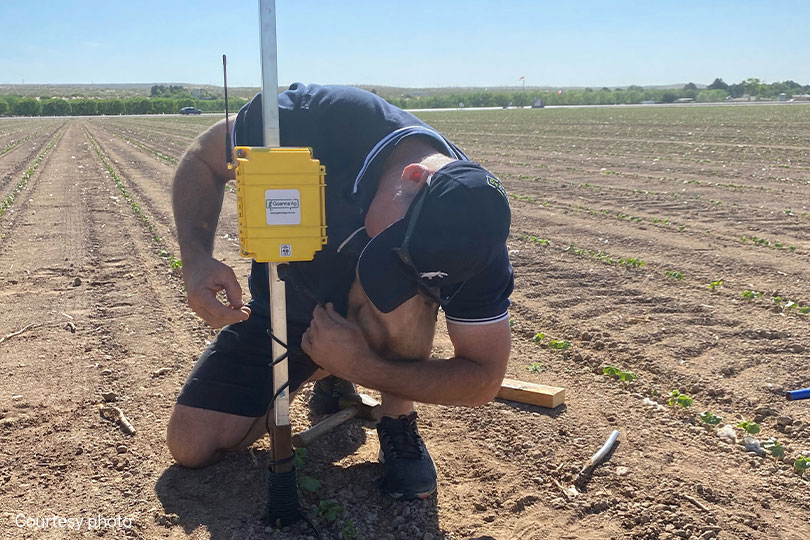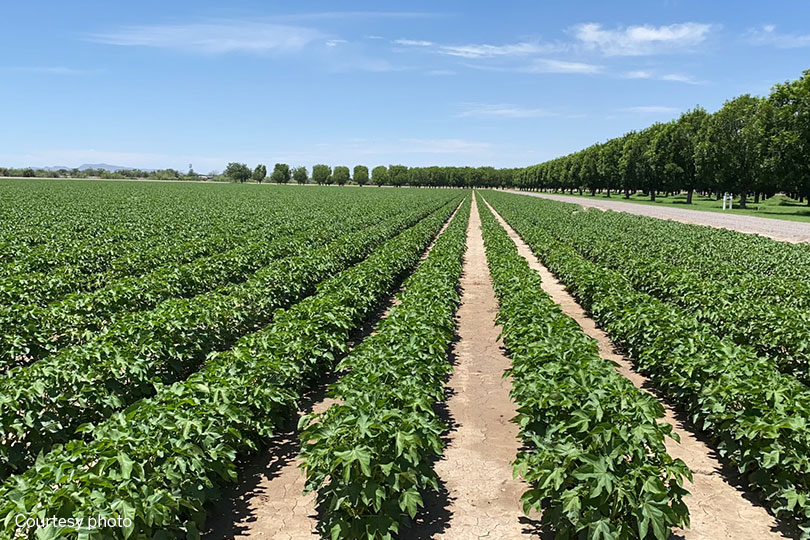By Emmy Powell
Communications Specialist
Drip irrigation was used to grow pima cotton successfully and efficiently for the first time in the El Paso Valley.
Alex Eveler, cotton farmer and crop consultant for Nutrient Ag Solutions in Brownfield, planted 12 acres of pima cotton on his family’s farmland in El Paso.
Eveler strives to preserve his family’s land. He said drip irrigation allowed him to conserve water and is a sustainable option.
“The drought has really affected agriculture in the lower valley,” Eveler said. “I’ve noticed a lot of the farmland being fallow for multiple years down there, and I saw a solution that could maybe help aid that and allow us to grow more crops with less water on a year-over-year basis.”
He noted the importance of being a good steward of the land.
“The lower valley of El Paso is forward-thinking, sustainable producers. I view it as an investment in the future, to be more efficient with our resources. Minimum tillage kind of goes hand-in-hand with all that and just trying to be better stewards of the land and grow more with less,” he said in an interview with the Texas Farm Bureau Radio Network.
Eveler harvested about 41 bales of cotton total.
“It’s kind of a proof of concept, what we did down there,” Eveler said. “It was a temporary system to make sure it would work. It did 3 bales approximately (per acre), but overall, for a pilot I’m pretty happy with the results. I think it’s shown that it’s worth looking into and proceeding with permanent systems.”
He plans to continue using drip irrigation on the entire farm, which is 70 acres.
Eveler said a large influence in using drip irrigation on the pima cotton was for water efficiency.

“Water use efficiency would be the biggest positive outlook for drip,” he said. “It allows you to apply irrigation as the crop needs it throughout the growing season. If you use soil monitors and moisture probes, you can apply exactly what the crop needs when the crop needs it, and not only with water, but with nitrogen and phosphorous, you can inject your fertilizers and insecticides as needed through the crop without having to put a tractor or other implement through the field. That helps with ease of operation and decreases labor needs, as well.”
The Valley is known to produce high-quality pima cotton because of its climate.
The drought, inflation and high agricultural input costs influenced Eveler’s decision to use drip irrigation instead of the traditional technique in the area, flood irrigation.
“With drip irrigation, the drought eases the need to change irrigation decisions, because you can give the crop what it needs when it needs it and be more efficient with water,” he said. “The drought certainly makes you want to build toward systems like this, because the alternative is not planting and not having enough water to flood or other systems, other conventional systems, wouldn’t allow you to even have a crop.”
Eveler noted a farmer’s decision to change irrigation techniques in the Valley has many influences but mainly cost and tradition.
“The infrastructure cost can be mounting, and it’s a big investment to make, especially if you’re not sure it’s going to work,” he said. “Flood irrigation has been done effectively down there for decades.”
Although techniques have been practiced and proved to work well, he noted the importance of adopting and creating more efficient practices and working to sustain the resources they have.
“It’s difficult to change management styles, especially in an aggressive way, that quickly,” Eveler said. “Agriculture has been a lot of times innovation by necessity, so it’s hard to make that change. I think that if we can prove that it works, it would certainly make it more of a comfortable change to make.”

